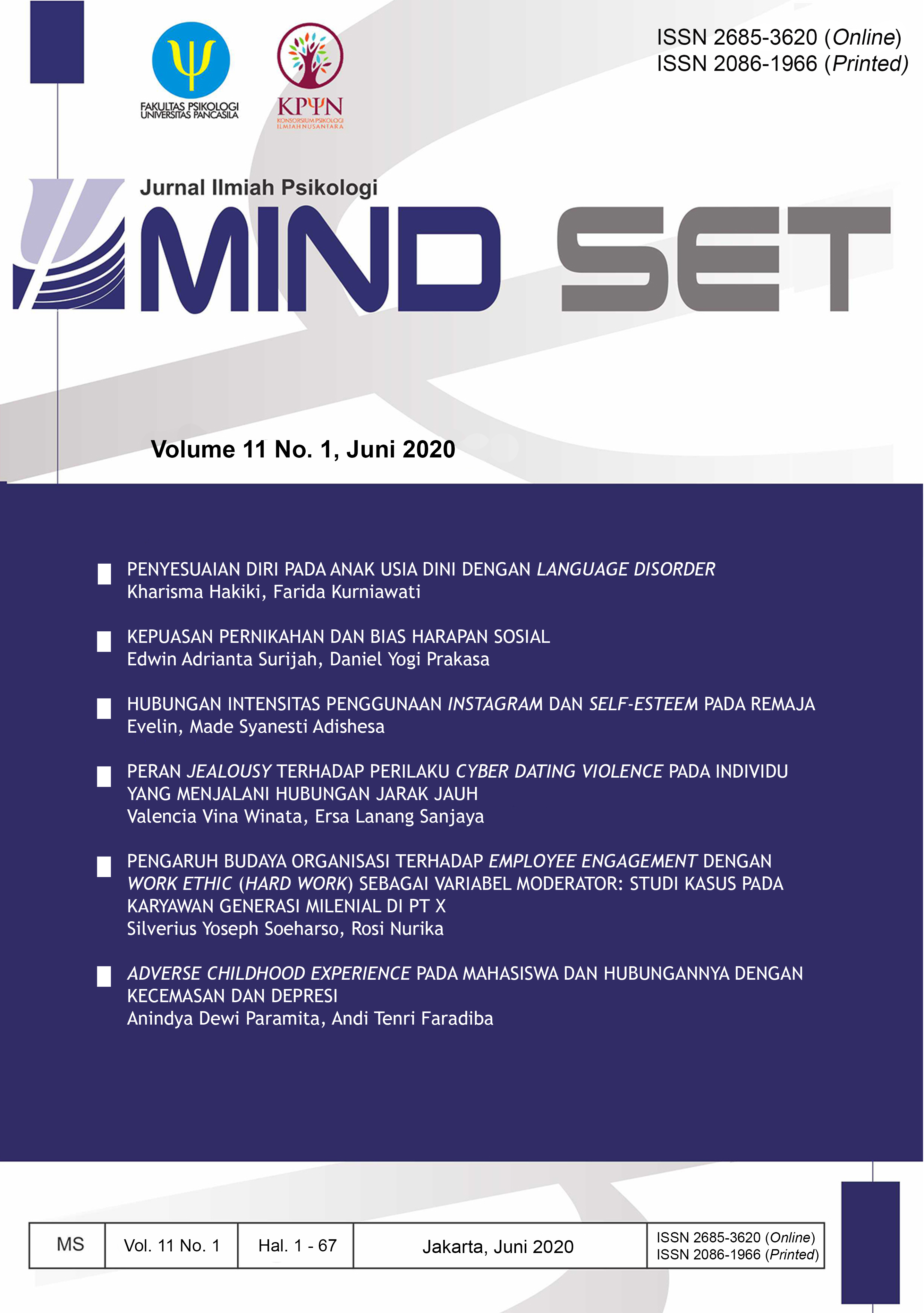The Effect of Jealousy on Cyber Dating Violence in People Who Have A Long Distance Relationship
DOI:
https://doi.org/10.35814/mindset.v11i01.1304Kata Kunci:
cyber dating violence, jealousy, long distance relationshipAbstrak
Tujuan dari penelitian ini adalah untuk mengetahui peran tingkat kecemburuan yang dapat mempengaruhi munculnya kekerasan dalam berpacaran melalui alat elektronik oleh individu yang sedang menjalani long distance relationship. Subjek penelitian berjumlah 166 individu yang pernah menjalani hubungan jarak jauh. Hasil penelitian kuantitatif ini diuji dengan uji regresi sederhana. Alat ukur yang digunakan dalam penelitian ini antara lain Cyber Dating Abuse Questionnaire (Borrajo, 2015) dan Multidimensional Jealousy (Pfeiffer & Wong, 1989). Hasil penelitian ini menunjukkan bahwa adanya pengaruh signifikan dari jealousy terhadap munculnya perilaku cyber dating violence. Dimensi behavioral jealousy memiliki pengaruh dengan sumbangan efektif sebesar 22.6% terhadap terjadinya cyber dating violence (R2 = 0,226; p=0,000).
Referensi
Andersen, P. A., Eloy, S. V., Guerrero, L. K., & Spitzberg, B. H. (1995). Romantic jealousy and relational satisfaction: A look at the impact of jealousy experience and expression. Communication Reports, 8(2), 77–85. doi:10.1080/08934219509367613
Aylor, Brooks & Dainton, Marianne. (2001). Antecedents in Romantic Jealousy Experience, Expression, and Goals. Western Journal of Communication.
Belus, J. M., Pentel, K. Z., Cohen, M. J., Fischer, M. S., & Baucom, D. H. (2018). Staying connected: an examination of relationship maintenance behaviors in long-distance relationships.Marriage & Family Review,121.doi10.1080/01494929.2018.1458004
Bevan, J. L., Finan, A., & Kaminsky, A. (2008). Modeling serial arguments in closerelationships: The serial argument process model. Human CommunicationResearch, 34, 600–624.
Beserra, M. A., Leitão, M. N., Fabião, J. A., Dixe, M., Veríssimo, C., & Ferriani, M. (2016). Prevalence and Characteristics of Dating Violence among School-Aged Adolescents in Portugal.
Bennett, D., Guran, E., Ramos, M., & Margolin, G. (2011). College students' electronic victimization in friendships and dating relation- ships: Anticipated distress and associations with risky behaviors. Violence and Victims, 26(4), 410–429.
Blázquez-Alonso, M., Moreno-Manso, J. M., & García-Baamonde, M. E. (2012). Indicators of psychological abuse associated with the length of relationships between couples. Anales de Psicología, 28, 772-779.
Borrajo, E., Gamez-Guadix, M., Pereda,N., & Calvete, E. (2015). The Development and Validation of the Cyber Dating Abuse Questionnaire among Young Couples. Computers in Human Behavior. 10.1016/j.chb. 2015.01.063.
Borrajo, E., Gamez-Guadix, M., & Calvete, E. (2015). Cyber dating abuse: Prevalence, context, and relationship with offline dating aggression. Psychological Reports: Relationships & Communications, 116, 565-585.
Brown, B., & Prinstein, M. (2011). Encyclopaedia of Adolescence. London: Elsevier Academic Press.
Burke, S., Wallen, M., Vail-Smith, K., & Knox, D. (2011). Using tech-nology to control intimate partners: An exploratory study of college undergraduates. Computers in Human Behavior, 27(3), 1162–1167.
Christofides, E., Muise, A., & Desmarais, S. (2009). Information disclosure and control on Facebook: Are they two sides of the same coin or two different processes?.Cyberpsychology &Behavior, 12(3), 341-345.
Deans, H., & Bhogal, M. S. (2017). Perpetrating cyber dating abuse: a brief report on the role of aggression, romantic jealousy and gender. Current Psychology. doi:10.1007/s12144-017-9715-4
Draucker, C.B. and Martsolf, D.S. (2010). The role of electronic communication technology in adolescent dating violence. Journal of Child and Adolescent Psychiatric Nursing, 23(3), 133-142.
Dye, M., & Davis, K. (2003). Stalking and psychological abuse: Common factors and relationship-specific characteristics. Violence and Victims, 18(2), 163–180.
Elphinston, R., Feeney, J., Noller, P., Connor, J., & Fitzgerald, J. (2013). Romantic jealousy and relationship satisfaction: The costs of rumination. Western Journal of Communication, 77(3), 293–304.
Firmin, M., Firmin, R., & Lorenzen, K. (2014). A qualitative analysis of loneliness dynamics involved with college long-distance relationships. College Student Journal, 48, 57-71.
Follingstad , D. R. , & Edmundson , M. (2010). Is psychological abuse reciprocal in intimate relationships? Data from a national sample of American adults . Journal of Violence. 25 , 495 - 508 .
Kurniati, G. (2015). Pengelolaan Hubungan Romantis Jarak Jauh (Studi Penetrasi Sosial Terhadap Pasangan Yang Terpisah Jarak Geografis Sejak Pacaran Hingga Menikah). Jakarta.
Larry& Carla. (2018). Jealousy, Possessiveness and Insecurity.https://larryandcarla.com/long-distance-relationships/living-with-a-long-distance-relationship/coping-with-jealousy/.
Lucero, J., Weisz, A., Smith-Darden, J., & Lucero, S. (2014). Exploring gender differences: Socially interactive technology use/abuseamong dating teens. Affilia, 29(4), 478–491.
Lumley, T., Diehr, P., Emerson, S., &Chen, L. (2002). The Importance of the Normality Assumption in Large Public Health Data Sets. Seattle-Washington: Department of Biostatistics, University of Washington Page 151-169.
Marazziti, D., Di Nasso, E., Masala, I., Baroni, S., Abelli, M.,Mengali, F., Mungai, F., & Rucci, P. (2003). Normal andobsessional jealousy: A study of a population of young adults. European Psychiatry, 18(3), 106–111.
Mendoza, M., & Mulford, C. (2018). Relationship dynamics and teen dating violence.
Pfeiffer, S. & Wong, P. (1989). Multidimensional Jealousy. Journal of Social and Personal Relationships - J SOC PERSON RELAT. 6. 181-196. 10.1177/026540758900600203.
Rill, L., Baiocchi, E., Hopper, M., Denker, K., & Olson, L. N. (2009). Exploration of the relationship between self- esteem, commitment, and verbal aggressiveness in romantic dating relationships. Communication Reports, 22, 102-113.https://doi.org/10.1080/08934210903061587.
Rodriguez, L. M., Dibello, A. M., Øverup, C. S., & Neighbors, C. (2015). The price of distrust: trust, anxious attachment, jealousy, and partner abuse. Partner Abuse, 6(3), 298–319. doi:10.1891/1946-6560.6.3.298.
Sebastián, J., Verdugo, A., & Ortiz, B. (2014). Jealousy and violence in dating relationships: gender-related differences among a Spanish sample. The Spanish journal of Psychology, 17.
Sesar, K., Dodaj, A., Simic, N., & Barisic, M. (2014). Predictors of violent behaviors in young adults dating relationships. Psychology and Behavioral Sciences, 3(6), 233–242.
Shackelford, T. (2001). Self-Esteem in marriage. Personality and Individual Differences, 30(3), 371–390.
Teten, A., Ball, B., Valle, L., Noonan, R., & Rosenbluth, B. (2009). Considerations for the definition, measurement, consequences, and prevention of dating violence victimization among adolescent girls. Journal of Women's Health, 18(7), 923–927.
Zweig, J. M., Dank, M., Yahner, J., & Lachman, P. (2013). The rate of cyber dating abuse among teens and how it relates to other forms of teen dating violence. Journal of Youth and Adolescence, 42, 1063-1077.https://doi.org/10.1007/s10964-013-9922-8.









